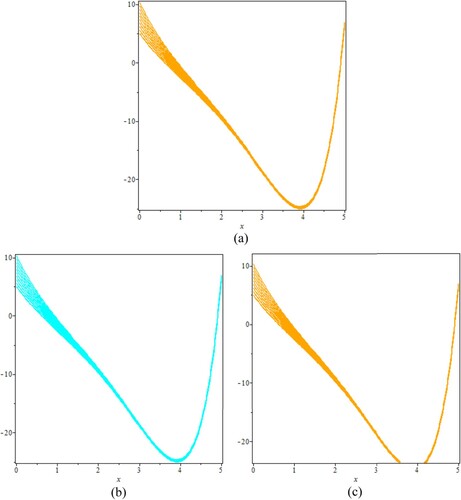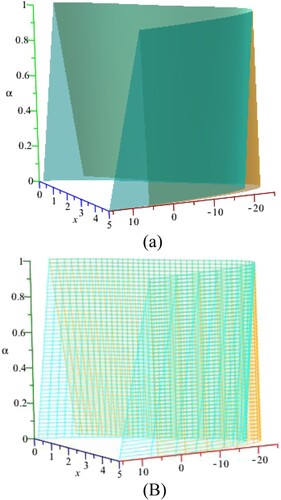 ?Mathematical formulae have been encoded as MathML and are displayed in this HTML version using MathJax in order to improve their display. Uncheck the box to turn MathJax off. This feature requires Javascript. Click on a formula to zoom.
?Mathematical formulae have been encoded as MathML and are displayed in this HTML version using MathJax in order to improve their display. Uncheck the box to turn MathJax off. This feature requires Javascript. Click on a formula to zoom.ABSTRACT
In this research, we suggested a numerical iterative scheme for investigating the numerical solution of fuzzy linear and nonlinear systems of equations, particularly where the linear or nonlinear system co-efficient is a crisp number and the right-hand side vector is a triangular fuzzy number. Triangular fuzzy systems of linear and nonlinear equations play a critical role in a variety of engineering, scientific challenges, mathematics, chemistry, physics, artificial intelligence, biology, medical, economics, finance, statistics, machine and deep learning, computer science, robotics and smart cars, programming, in the military and engineering industries, linear and nonlinear programming problems and traffic flow problems. In biomedical engineering, fluid flow problems, and differential equations, triangular fuzzy linear and nonlinear systems of equations also play a key role in determining the level of uncertainty. Convergence analysis illustrates that the proposed numerical technique's order of convergence for solving a triangular fuzzy system of linear and nonlinear equations is three. The newly developed numerical scheme was then applied to solve several triangular fuzzy boundary value problems. In terms of convergence rate, computing time, and residual error, numerical test problems indicate that the newly developed methods are more efficient than the current methods in the literature.
Introduction
Numerous scientific, mathematical and engineering problems are simulated using real data, most of which are ambiguous, incorrect, or insufficient. In other words, detailed information regarding parameter values, functional relationships, or initial conditions is not provided. In these cases, the selected behaviour of the system can only be estimated using existing analytical or numerical techniques. For example, by changing the values of unknown parameters to more reliable ones. It is impossible to describe the behaviour of a whole system based on incomplete knowledge. Thus, in many dynamical models, a system of nonlinear equations occurs. Nonlinear systems of equations, rather than a single bit, are widely used to describe a wide range of real-world problems. The uncertainty in these types of linear or nonlinear systems of equations can be well represented by triangular fuzzy numbers, and such a system is known as a triangular fuzzy system of linear or nonlinear equations. Triangular fuzzy linear and nonlinear systems of equations are not often solved using analytical methods. As a result, because of their wider range of stability and consistency, we look to numerical iterative schemes.
The fuzzy set and fuzzy logic theories were initially put forward by Zadeh in a number of books and series of papers e.g. [Citation1,Citation2]. This improvement enables the extension of the crisp mathematical concept into fuzzy information. Theoretically, Dubois and Prade [Citation3,Citation4], Tanaka and Mizumoto [Citation5,Citation6], Chang et al. [Citation7] and Nahmias [Citation8] established the fundamental operations and studied fuzzy numbers techniques. Goetschel et al. [Citation9] presented the parametric form of fuzzy numbers and the concept of fuzzy calculus. They went one step further and integrated the parametric fuzzy number set into a topological vector space. The concept of triangular fuzzy numbers was first introduced by Moghadam et al. [Citation10]. Furthermore, Wu et al. [Citation11] and Puri et al. [Citation12] examined a variety of other useful literary ideas in reference to their previously published work. Both engineering and science frequently employ linear systems. When attempting to solve a problem, we estimate most of the time. Instead of using crisp numbers to convey a few parameters, several applications employ triangular fuzzy and broader fuzzy. Numerical techniques must be proposed in order to properly analyse and solve triangular fuzzy linear and nonlinear systems of equations (TFSNEs). Many fields of technology and engineering sciences, including telecommunications, statistics, economics, social sciences, image processing, and even physics, use parametric fuzzy numbers (PFNs) [Citation13–15] to solve fuzzy systems of linear equations (FSLEs) with real crisp coefficient entries and vectors on the right-hand side. For more details on triangular fuzzy number (TFN) and their applications, see e.g. [Citation16–23].
To approximate roots of fuzzy non-linear equations or system of nonlinear equations, Abbsbandy et al. [Citation24] used Newton Raphson method, Ibrahim et al. [Citation25] used Levenberg-Marquest Method, Mosleh et al. [Citation26] used Adomian Decomposition Method, [Citation27,Citation28], modify existing iterative methods [Citation29], used Levenberg-Marquardt method [Citation30], used numerical techniques to solve fuzzy dynamic system see also [Citation31,Citation32]. The primary goal of this research is to suggest an efficient higher order iterative approach that outperforms well-known classical methods such as the Newton–Raphson method [Citation6,Citation33].
To develop and analyse higher order efficient numerical schemes for solving TFSNE, however, almost no work has been done. Consequently, there is a lot of potential for advancement and development in these areas. Since not much work has been done, we must establish the basic aspects and findings that are necessary for the proper development of this domain. Motivated by the aforesaid work, in this article, we have developed higher order numerical scheme to solve the TFSNEs and TFBVPs. In the future, this article may help other researcher with the further development of this topic.
The following are the article's main contributions:
Define TFN and its arithmetic operations
Use a parametric form of TFN in TFSNEs
Proposed new numerical iterative scheme in Triangular fuzzy environment
Compute theoretical convergence order of the proposed method using convergence analysis
Numerical test examples are given to demonstrate the precision and accuracy of the suggested approach and the graphically shown result of the problem
Some triangle fuzzy boundary value problems, both linear and nonlinear, are considered and solved
The results of our proposed method are compared to those of existing methods
Preliminaries
Definition 1:
A fuzzy number is a fuzzy set like which satisfies [Citation34],
is upper semi-continuous,
outside some interval
,
There are real numbers
such that ë
and
is monotonic increasing on
,
is monotonic decreasing on
,
, for
We denote by the set of all fuzzy numbers. An equivalent parametric form is also given in Ref. [Citation35] as follows.
Definition 2:
[Citation36] A fuzzy number in parametric form is a pair
of function
which satisfies the following requirements:
is a monotonic increasing left continuous function that is bounded.
is a monotonic decreasing left continuous function that is bounded.
A popular fuzzy number is trapezoidal fuzzy number denoted by
is a fuzzy number with membership function as:
and its parametric from is.
if
then
is known as triangular fuzzy number.
Definition 3:
[Citation37] A is said to be
iff ë
and denoted by
Definition 4:
[Citation37] Two triangular fuzzy number.
are said to be equal iff
ë
ă
and ë
ă
for all
and
Definition 5:
[Citation38] In triangular fuzzy numbers, extend addition, scalar multiplication, and extend multiplication are defined as if
and
,
,
and
then
and
Construction of Iterative Scheme (SFQM1)
Consider the following triangular fuzzy non-linear system of equations
We propose the two-step iterative scheme to solve TFSNEs as follows:
Suppose that
is the solution of above system and
,
, … ,
is approximate solutions of the system then
By using Taylor's series of
about
we then have
where ,
and
If
are close to
then
are small enough. Assume all partial derivatives of
exist and bounded, then we have:
Since are unknown quantities, they are obtained by solving the following equations
where
where
the next approximation for
are found by using recursive scheme as follows: where
and
andwhere
,
and
For initial guess, one can use the fuzzy number
Remark:
Sequence
converges to iff
Lemma Let
and if the sequence of
converges to
and
according to M, then
where
and
Proof It is obvious, because for all in convergent case,
Hence proved.
Finally, it is proven that the SFQM1 technique for solving TFSNEs is cubic convergent under certain conditions. For , in compact form, the SFQM1 fuzzy iterative technique can be written as follows:
Theorem Let
be u-times Frěchet differential function on a convex set H containing the root
of
, then MM method has cubic convergence and satisfies the following error equation.
where
The classical Newton Raphson’s approach is a well-known existing method in the literature [Abb-1] for solving TFSNEs equations (abbreviated as SFQN1), and it is as follows:
where
and
,
,
.
Numerical applications
The performance and efficiency of the SFQM1 and SFQN1 methods for solving TFNSEs are demonstrated in this section [Citation39,Citation40]. All calculations are performed in CAS Maple 18 with the following stopping criteria:
where
represents the absolute error.
Example 1:
Consider the triangular fuzzy linear system of equation
Assuming
is positive, the parametric form of this equation is as follows:
In matrix form, the above triangular fuzzy linear system of equations is written as:
The exact solution in parametric form to the aforementioned triangular fuzzy linear system of equations is:
The triangular fuzzy linear system’s exact solution, in non-parametric form, is as follows:
and
Consequently
and
After 4 iterations, we obtain the solution with the maximum error less than
. Now suppose
is negative, we have
For
we have,
therefore negative solution does not exist.
Table (a,b) shows the numerical approximate solution of TFNSEs using SFQM1 and SFQN1. Table (a,b) clearly demonstrates that our newly created fuzzy iterative technique outperforms SFQN1 in terms of error and CPU time throughout the same number of iterations, i.e. 3. Theoretical order of convergence matches local [Citation41] computational order of convergence (COC) even more closely.
Table 1. (a) SFQM1 and SFQN1 comparison. (b) Error comparison of SFQM1 and SFQN1.
Example 2:
Consider TFNSEs
Assuming
is positive, the parametric form of this equation is as follows:
In matrix form, the above triangular fuzzy linear system of equations is written as:
The exact solution in parametric form to the aforementioned triangular fuzzy linear system of equations is:
The triangular fuzzy linear system's exact solution, in non-parametric form, is as follows:
The exact negative solution of the fuzzy linear system is given as:
To obtain an initial guess, we use the above system for
and
therefore
and
Consequently
and
After 4 iterations, we obtain the solution with the maximum error less than
. Similarly, we approximate the solution when
is negative.
Table (a,b) shows the numerical approximate solution of TFNSEs using SFQM1 and SFQN1. Table (a,b) clearly demonstrates that our newly created fuzzy iterative technique outperforms SFQN1 in terms of error and CPU time throughout the same number of iterations, i.e. 3. Theoretical order of convergence matches local computational order of convergence even more closely.
Table 2. (a): SFQM1 and SFQN1 comparison. (b) Error comparison of SFQM1 and SFQN1.
Example 3:
Buckling of a Thin Vertical Column
Leonhard Euler was one of the first mathematicians to analyse an eigenvalue problem in the eighteenth century when analysing how a thin elastic column collapses under a compressive axial force. Take a look at a long, slender vertical column with a uniform cross-section and length L. Let y(x) represent the column's deflection when a constant vertical compressive force, or load, P is applied to its top. The fuzzy boundary value problem is obtained by comparing uncertain bending moments at any location along the column (TFBVP-I)
where E is Young’s modulus of elasticity and I is the moment of inertia of a cross-section about a vertical line through its centroid and have uncertainty in its value. Therefore
where
and have fuzzy value is
In parametric form, the above TFBVP-I is written as:
We use difference approximation of
by choosing an integer
to discretize the domain
into n + 1 equal subinterval, where a and b are the boundary points i.e.
Thus by using third degree Taylor polynomial, we expand
about
at
and
as:
for some
,
and
for some
,
By adding
and
we have:
Similarly, we use the central difference to approximate
i.e.
where
are fuzzy variable. Now in the parametric form of
,
are given as:
and
Using these above, TFBVP-I is written as follows:
For each
and
we obtained the following linear system of equation
as
where
Lower approximation of TFBVP-I is given as by lower approximation i.e. ,
we obtain the following linear system of equations
where
The TFBVP-I solution is numerically approximated in Table using SFQM1 and SFQN1. Table clearly shows that our newly developed fuzzy iterative technique exceeds SFQN1 in terms of error and CPU time throughout the same number of iterations, i.e. 3. Theoretical order of convergence matches local computational order of convergence even more closely.
Table 3. (a) Comparison of solution of TFBVP-I using SFQM1 and SFQN1. (b) Error comparison of SFQM1 and SFQN1 for solving TFBVP-I.
The Exact solution of the TFBVP-I is
and
Example 4:
Fuzzy Boundary Value Problem
Consider TFBVP-II
where
and have fuzzy value is
In parametric form, the above TFBVP-II is written as:
For each
and
we obtained the following linear system of equation
as
where
Lower approximation of TFBVP-II is given as by lower approximation i.e. ,
we obtain the following triangular fuzzy linear system of equations as:
where
The TFBVP-II solution is numerically approximated in Table using SFQM1 and SFQN1. Table clearly shows that our newly developed fuzzy iterative technique exceeds SFQN1 in terms of error and CPU time throughout the same number of iterations, i.e. 3. Theoretical order of convergence matches local computational order of convergence even more closely.
Table 4. (a) Comparison of solution of TFBVP-II using SFQM1 and SFQN1. (b) Error comparison of SFQM1 and SFQN1 for solving TFBVP-II.
Results and discussion
Here, we discuss the superiority of the numerical method SFQM1 over existing method SFQN1 in the literature in terms of efficiency, residual errors and computational time in seconds. The approximate solutions to the TFNSEs for various values of the fuzzy parameter r are shown in Tables (a) and (a), and the comparison of the exact and approximate solutions to the TFBVPs–I and TFBVP–II is shown in Tables (a) and (a). In terms of iterations, residual error computation time in seconds (CPU), and computational order of convergence, Tables (b)–(b) demonstrate that our recently created approach, SFQM1, is more effective than SFQN1. The approximate numerical solution for the TFSLEs and TFSNEs utilized in examples 1 and 2 is shown in Figures (a–f)– using the SFQM1 and SFQN1 methods. The exact and approximate solutions to the TFBVPs-I and TFBVP-II are compared in Figure –6. It is evident from all of Figures that SFQM1 exhibited better convergence behaviour than SFQN1 in terms of efficiency and errors.
Figure 1. (a–f) The numerical approximate solutions of the triangular Fuzzy nonlinear system of equations used in Example 1 via SFQM1, SFQN-methods. To obtain initial guess, we use above system for and
therefore, (a) approximate positive solution of
, (b) approximate positive solution of
(c) approximate positive solution of
, (d) approximate positive solution of
, (e) approximate positive solution of
, and (f) combine solution of (TFSLEs)-1.
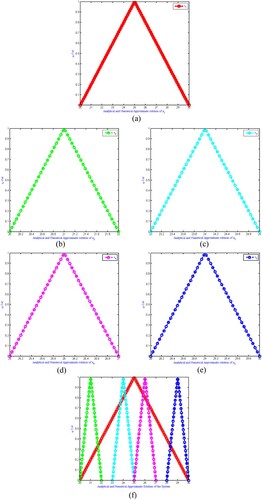
Figure 2. The numerical approximate positive solutions of the triangular Fuzzy nonlinear system of equations used in Example 2 via SFQM1, SFQN-methods.
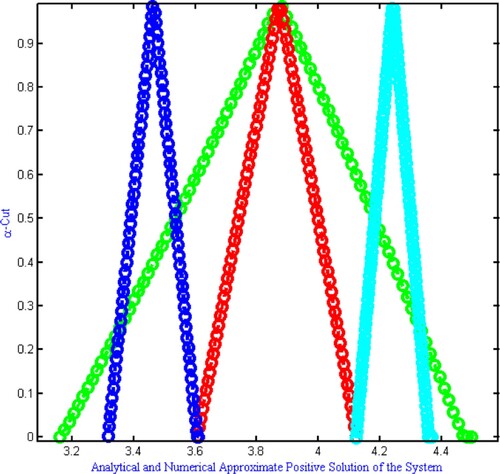
Figure 3. (a) The exact and approximate solutions for , (c) The solution for
. The numerical approximate solution to the fuzzy boundary value problem is the same as the exact answer, as shown in (b, d). Exact solution of
, approximate solution of
, (c) exact solution of
, (d) approximate solution of
.
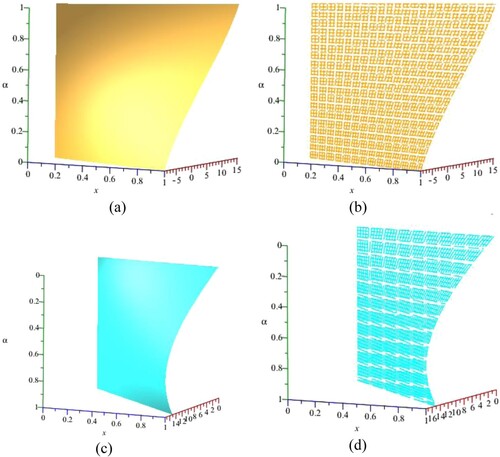
Figure 4. (a,b) The exact and numerical approximate solutions obtained using the SFQM1-iterative method. This figure clearly indicates that the approximate solution matched the actual solution. (a) Exact solution of TFBVP-1 and (b) approximate solution of TFBVP-1.
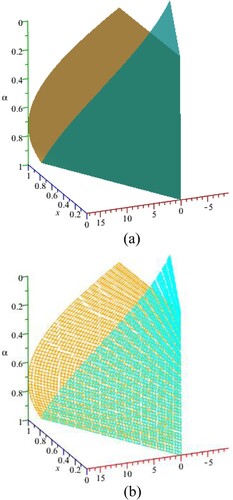
Conclusion
We developed a highly efficient numerical iterative scheme for solving triangular fuzzy linear and nonlinear systems of equations in this paper. Numerical test examples and two FBVP solutions illustrating the practical performance and dominance efficiency of the SFQM1 approach over the SFQN1 method on the same number of iterations. In comparison to the SFQN1 approach, the numerical results of SFQM1 methods are better in terms of absolute error and CPU time, as shown in Tables (a,b)–(a,b) and Figures . Using the same methodologies as described in this article, and using technique of weight function we can construct optimal fourth-order efficient numerical iterative methods for solving systems of fuzzy linear and nonlinear equations using more generalized fuzzy numbers, i.e. intuitionistic fuzzy number [Citation13], trapezoidal fuzzy number [Citation37], bipolar fuzzy number [Citation40], hesitant fuzzy number [Citation42–44], etc.
Disclosure statement
No potential conflict of interest was reported by the author(s).
References
- Zadeh LA. Fuzzy sets. Inf Control. 1965;8:338–353.
- Zadeh LA. The concept of a linguistic variable and its application to approximation reasoning. Inf Sci. 1975;3:199–249.
- Dubois D, Prade H. Operations on fuzzy numbers. J Syst Sci. 1978;9:613–626.
- Dubois D, Prade H. Fuzzy sets and systems: theory and application. New York: Academic Press; 1980.
- Mizumoto M, Tanaka K. The four operations of arithmetic on fuzzy numbers. Syst Comput Controls. 1976;7(5):73–81.
- Mizumoto M, Tanaka K. Some properties of fuzzy numbers. In: Gupta MM, Ragade RK, Yager RR, editors. Advances in fuzzy Set theory and applications. Amsterdam: North-Holland; 1979. p. 156–164.
- Chang SSL, Zadeh LA. On fuzzy mapping and control. IEEE Trans Syst Man Cybern. 1972;2:30–34.
- Nahmias S. Fuzzy variables. Fuzzy Sets Syst. 1978;12:97–111.
- Goetschel R, Voxman W. Elementary calculus. Fuzzy Sets Syst. 1986;18:31–43.
- Moghadam KG, Ghanbari R, Amiri NM. Duality in bipolar triangular fuzzy number quadratic programming problems. In Proceedings of the International Conference on Intelligent Sustainable Systems, Palladam, Tirupur, India, 7–8 December 2017; pp. 1236–1238.
- Congxin W, Ming M. On embedding problem of fuzzy number spaces. Fuzzy Sets Syst. 1991;44:33–38.
- Puri ML, Ralescu D. Differential for fuzzy function. J Math Anal Appl. 1983;91:552–558.
- Keyanpour M, Akbarian T. Solving intuitionistic Fuzzy nonlinear equations. J Fuzzy Set Value Anal. 2014;2014:1–6.
- Buckley JJ, Qu Y. Solving linear and quadratic fuzzy equation. Fuzzy Sets Syst. 1990;38:43–59.
- Buckley JJ, Qu Y. On using a-cuts to evaluate equations. Fuzzy Sets Syst. 1990;38:309–312.
- Buckley JJ, Qu Y. Solving fuzzy equations: a new solution concept. Fuzzy Sets Syst. 1991;39:291–301.
- Buckley JJ, Qu Y. Solving systems of linear fuzzy equations. Fuzzy Sets Syst. 1991;43:33–43.
- Jajarmi A, Baleanu D, Zarghami KV, et al. A general fractional formulation and tracking control for immunogenic tumor dynamics. Math Methods Appl Sci. 2022;45(2):667–680.
- Erturk VS, Godwe E, Baleanu D, et al. Novel fractional-order Lagrangian to describe motion of beam on nanowire. Acta Phys Pol A. 2021;140(3):265–272.
- Jajarmi A, Baleanu D, Zarghami Vahid K, et al. A new and general fractional Lagrangian approach: a capacitor microphone case study. Results Phys. 2021;31:104950.
- Baleanu D, Abadi MH, Jajarmi A, et al. A new comparative study on the general fractional model of COVID-19 with isolation and quarantine effects. Alexandria Eng J. 2022;61(6):4779–4791.
- Kumar A, Malik M, Sajid M, et al. Existence of local and global solutions to fractional order fuzzy delay differential equation with non-instantaneous impulses. AIMS Math. 2022;7:2348–2369.
- Khan MB, Srivastava HM, Mohammed PO, et al. Fuzzy-interval inequalities for generalized convex fuzzy-interval-valued functions via fuzzy Riemann integrals. AIMS Math. 2022;7:1507–1535.
- Abbasbandy S, Ezzati R. Newton's method for solving system of fuzzy non-linear equations. Appl Math Comput. 2006;175(2):1189–1199.
- Allahviranloo T, Asari S. Numerical solution of fuzzy polynomial by Newton-Raphson method. J Appl Math Islam Azad Univ Lahijan. 2011;7(4 (27)):17–44.
- Mosleh M. Solution of dual fuzzy polynomial equations by modified Adomian decomposition method. Fuzzy Inf Eng. 2013;5:45–56.
- Koam A, Akram M, Muhammad G, et al. LU decomposition scheme for solving m-Polar Fuzzy system of linear equations. Math Probl Eng. 2020;2020:1–19.
- Akram M, Muhammad G, Koam ANA, et al. Iterative methods for solving a system of linear equation in bipolar fuzzy environment. Mathematics. 2019;7(728):1–25.
- Sulaiman IM, Mamat M, Waziri MY, et al. Solving fuzzy nonlinear equation via levenberg-marquardt method. Far East J Math Sci. 2018;103:1547–1558.
- Ma J, Feng G. An approach to H1 control of fuzzy dynamic systems. Fuzzy Sets Syst. 2003;137:367–386.
- Cho YJ, Huang NJ, Kang SM. Nonlinear equations for fuzzy mapping in probabilistic normed spaces. Fuzzy Sets Syst. 2000;110:115–122.
- Dennis JE, Schnabel RB. Numerical methods for unconstrained optimization and nonlinear equations. Hoboken, NJ: Prentice-Hall; 1983.
- Fang J. On nonlinear equations for fuzzy mappings in probabilistic normed spaces. Fuzzy Sets Syst. 2002;131:357–364.
- Shiri B, Irina P, Alijani Z. Classical approximation for fuzzy Fredholm integral equation. Fuzzy Sets Syst. 2021;404:159–177.
- Zimmermann HJ. Fuzzy sets theory and its application. Dordrecht: Kluwer Academic Press; 1991.
- Yao JS, Lin FT. Constructing a fuzzy flow-shop sequencing model based on statistical data. Int J Approximation Reason. 2002;29:215–234.
- Rafiq N, Yaqoob N, Kausar N, et al. Computer-Based Fuzzy numerical method for solving engineering and Real-World Applications. Math Probl Eng. 2021;2021:1–13.
- Mikaeilvand N, Noeiaghdam Z, Noeiaghdam S, et al. A novel technique to solve the fuzzy system of equations. Mathematics. 2020;8(5):850.
- Saqib M, Akram M, Shahida B. Certain efficient iterative methods for bipolar fuzzy system of linear equations. J Intell Fuzzy Syst. 2020;39(3):1–15.
- Akram M, Muhammad G, Allahviranloo T. Bipolar fuzzy linear system of equations. Comput Appl Math. 2019;38(69):1–29.
- Akram S, Shams M, Rafiq N, et al. On the stability of Weierstrass type method with King's correction for finding all roots of non-linear function with engineering application. Appl Math Sci. 2020;14(10):461–473.
- Qian G, Wang H, Feng X. Generalized hesitant fuzzy sets and their application in decision support system. Knowl Based Syst. 2013;37:357–365.
- Rasham T, Shabbir MS, Agarwal P, et al. On a pair of fuzzy dominated mappings on closed ball in the multiplicative metric space with applications. Fuzzy Sets Syst. 2022;437:81–96.
- Bataineh M, Alaroud M, Omari SA, et al. Series representations for uncertain fractional IVPs in the Fuzzy conformable fractional sense. Entropy . 2021;23(12):1646.

